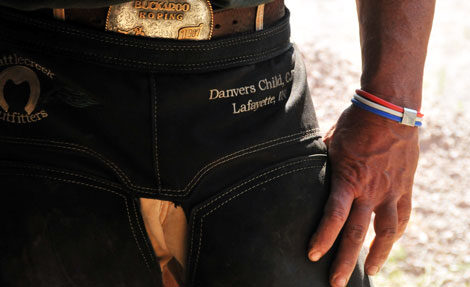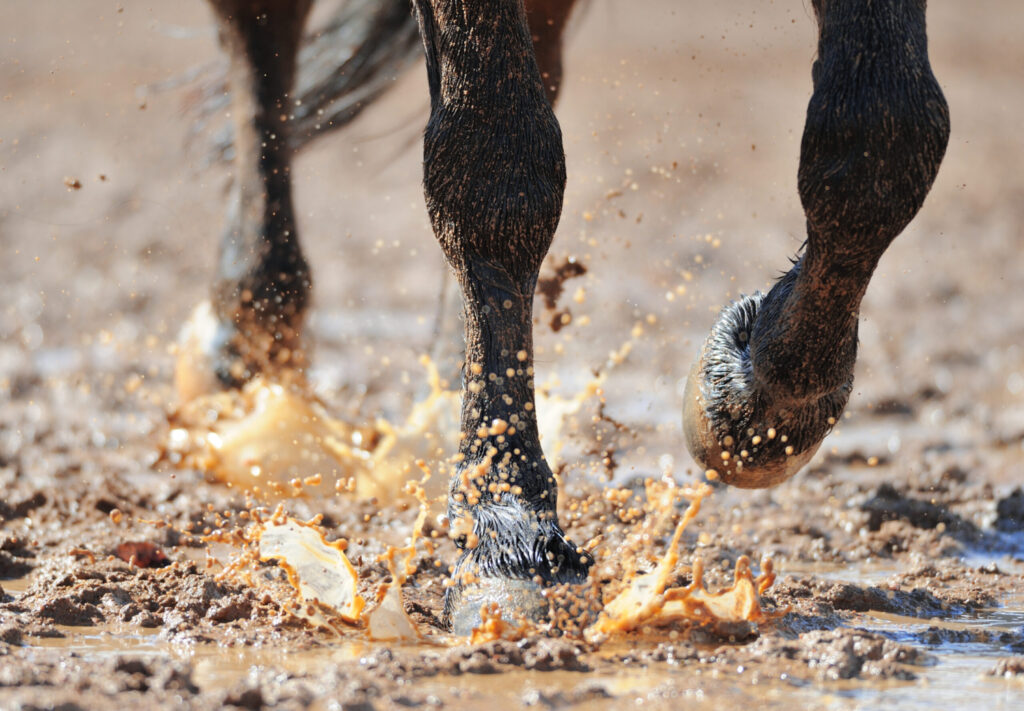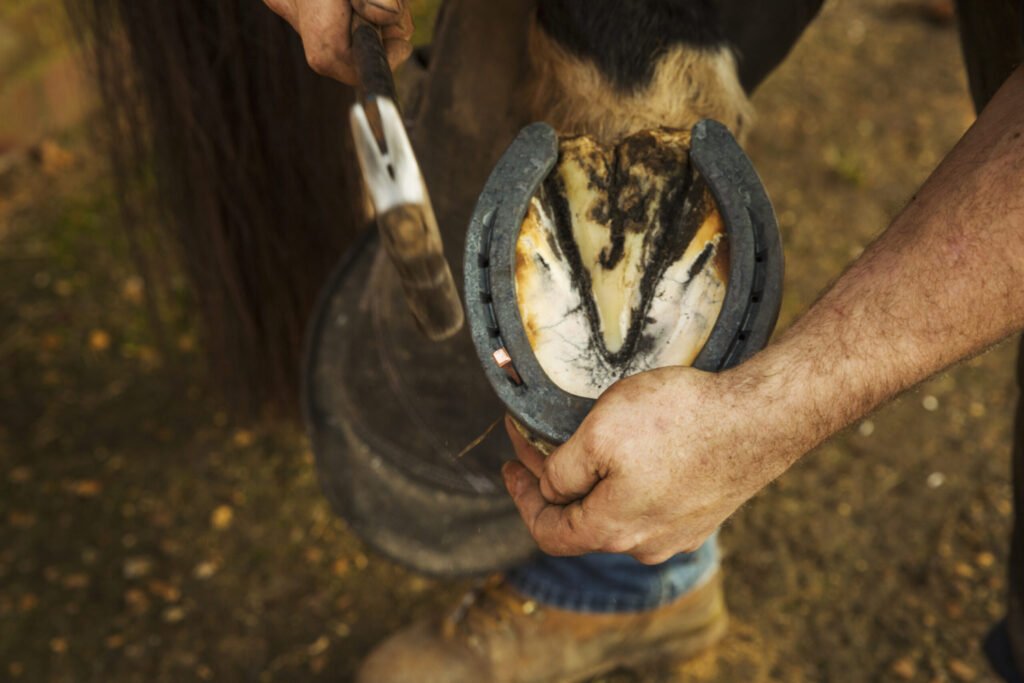Brought to you by: SmartPak
“No hoof, no horse!” If you’ve been around the horse industry for any length of time, no doubt you’ve heard the saying. It may seem a bit cliché, but the maxim is absolutely true. After all, hooves are a horse’s literal foundation, responsible for its very function and survival. Healthy hooves are integral to a horse’s well-being.
We all know hoof health is essential all year round, but many of us are guilty of falling into a routine when it comes to hoof care. We don’t necessarily take into consideration how the changing seasons can impact our horse’s hooves—and that impact can be significant. Danvers Child, a lifelong horseman, inductee of the International Horseshoeing Hall of Fame, and

Certified Journeyman Farrier, shares his top tips for keeping hooves healthy through seasonal challenges.
1. This is worth repeating again and again: regular hoof maintenance is critical.
“When it comes to the hoof health basics, your primary focus should be regular maintenance. Keeping a horse on a reasonable schedule—whether that’s every four, five, or six weeks—is the first step in keeping your horse’s feet healthy.”
2. Seasonal changes affect your horse’s biology, and therefore their hoof growth. During the fall and winter, hoof growth slows down.
“Your horse’s coat and hooves are both keratin-based, so during the winter, your horse’s growing winter coat will utilize a significant portion of those nutrients so hoof growth will slow down a little. When horses slough that hair coat, all those nutrients go back to hoof production. So, in the fall, you’ll see hoof growth slow down; in the spring, it’ll pick back up. This is going to vary based on your horse-keeping practices. Horses kept in a heated barn or with insulated blankets may not experience changes.”
3. Pay attention to moisture levels!

“I started out shoeing in Arkansas and Texas, where I didn’t encounter many climate-related hoof problems. When I moved to what I call ‘the great Mid-Wet’ here in northwest Indiana, I had to learn how to shoe better. It might be harder on farriers and tools to shoe a dry foot, but it’s much more difficult to maintain a wet foot.
“When there’s a lot of moisture, the hoof capsule weakens and distorts, which diminishes its structural integrity and shock absorbing capabilities. Additionally, any distortion in the hoof can lead to a separation of the white line, which creates an opportunistic environment for bacteria. That’s where we get most of our abscesses.
“Unfortunately, overly moisturized hooves often look better, but it’s all superficial. A dryer hoof might have some cracks and chips, but it’s a lot stronger. The bottom line: Anything that you can do to keep a hoof dry is usually not a bad thing.”
4. Turn your horse out when there’s less environmental moisture.
“If you turn your horse out at night or early in the morning, they’re going to encounter more dew and moisture.”
5. Avoid sudden shifts in moisture exposure.
“You’ll have a horse that comes in from morning pasture with lots of dew on his feet being but into a stall with dried shavings, which suck the moisture right out. The hoof might go from 28% moisture to 26%. It may not seem like a drastic change, but that constant fluctuation can cause a breakdown of keratin in the hoof. Anything you can do to avoid those constant shifts is very helpful.”
6. Use hoof hardeners more than hoof moisturizers.
“I want to reiterate that anything you can do to regulate the moisture is a good thing. There are topicals, like Keratex Hoof Hardener and Durasole, that will help strengthen the hoof structure and fight oversaturation. Again, I encourage the use of a drying agent rather than a moisturizing agent.”
7. Consider having a shorter shoeing cycle during summer months.
“During the summer, horses not only have more nutrients available for hoof growth, but they also tend to be ridden more. Activity increases vascularity and vascularity increases hoof growth. During the summer it’s not unusual to see your farrier more frequently, shortening the shoeing cycle by about a week.”

8. Supplements can help hooves stay healthy despite the elements.
“SmartHoof products and Farrier’s Formula are my go-to biotin-based products. Biotin-based products will give a better, stronger hoof; however, they don’t actually increase hoof growth. SmartCirculate is a product that will actually help hooves grow. It stimulates circulation, which will, in turn, accelerate hoof growth.”
9. Know the signs of unhealthy hoof structure.
“Flaring is probably the most obvious. The bottom of the hoof should mirror the coronary band at the top; it should be reasonably uniform from that point down. If you have a lot of distortion in the bottom of the foot, that’s a red flag in most cases.
“With cracks, you have superficial cracks and penetrating cracks. Superficial cracks aren’t really cause for worry, but penetrating cracks are an issue.
“This one is much harder for the layperson to see, but the hoof should be under the bony column of the leg. The nature of hoof growth works against that because there is an oblique angle at the pastern. The hoof grows forward as much as it grows downward. When you hear farriers talk about backing a foot up, we’re working to get it balanced under the limb; we want to keep the hoof capsule collected under the bony column. If you see a hoof that is migrating forward and doesn’t look substantive under that bony column, you’re going to start seeing soft tissue structures get negatively affected.
10. Fly control and joint health are also important for hoof soundness.
“During the spring and summer, flies can cause horses to stomp a lot. That repeated stomping can damage hooves. Use whatever fly control methods you have at your disposal: feed-through fly control, insecticides, and topicals.
“There’s also a tremendous relationship between joint health and hoof health. As horses age, they start getting arthritis and other joint issues, which can cause uneven landing and loading on the hoof. That imbalance can cause hoof issues. So staying on top of your horse’s joint health is important for their hooves as well.”









